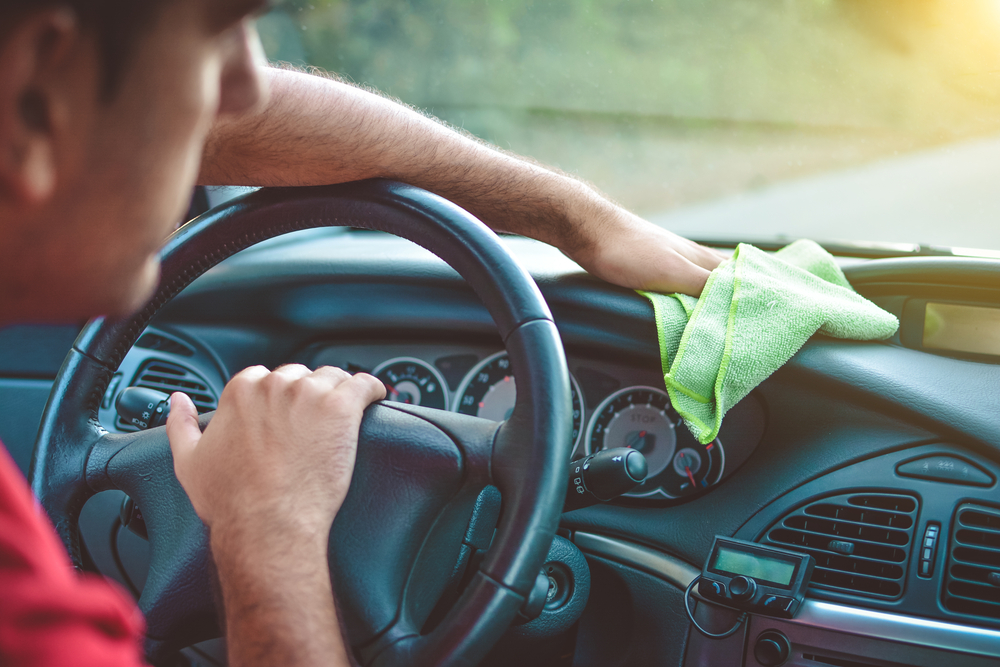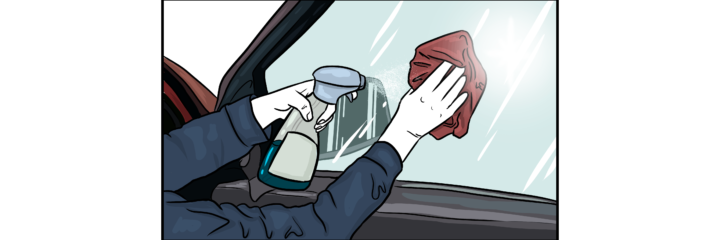Keeping your car windows clean inside and outside is more important than you might think as it helps you stay safe and confident on the road. It might seem like a hassle to take on the problem, but once you develop a routine, you’ll notice it’s not too hard.
Basic Preparations
There is some general preparation work you should consider. It makes sense to wash and clean your car both inside and outside before you get started on the glass; that way, no dust or debris will be stirred up and land on your newly cleaned windows.
As soon as that’s done, move your vehicle out of the sun (or wash it in the shade in the first place). Otherwise, cleaning agents might evaporate too quickly and leave smudges on the glass, potentially making your windows appear even dirtier than they were before you started the process.
The Two Major Cleaning Methods
As with all things in life, there are many approaches to the problem, but to make it easier for you to get started, we’ll present you two of the most straightforward ones: one that involves household items only and another one that uses specialized car cleaning agents.
The Household Materials Method
If you don’t want to work with intense cleaning supplies or don’t have the time to get specialized tools and agents, this method is for you. You’ll be delighted to know that your grandparents were right: you can use old newspapers to clean windows, including those of your car. Household staples like vinegar and rubbing alcohol can be repurposed as glass cleaners, too.
Keep in mind that this method won’t necessarily yield perfect results and you might have to go through a few newspapers in the process, but at least you don’t have to go out and get extra materials.
Whatever you do, don’t use ammonia-based cleaners you might find in your house. The fumes can be harmful to your health when trapped in a sealed-off environment, and the chemical might attack the plastic or rubber used in your vehicle. These cleaners also don’t play nicely with paint.
What you need
- Newspapers
- White vinegar
- Water
- Spray bottle
First, you’ll need to create your own glass cleaner. The Spruce recommends a simple mixture of 1 part white vinegar and 1 part water, which you fill into a spray bottle. This should give you a streak-free experience. If your windows are particularly dirty and greasy, you might want to introduce rubbing alcohol to the mix: 1 part water, 1 part rubbing alcohol, and 1 tablespoon vinegar.
You should then test the newspapers on a small, discreet surface — depending on the composition of the glass used in your car and the printing technique of the paper, you might get smudges, leftover fibers, or even scratches. If you notice any problems with these materials, you should switch to microfiber towels before proceeding. That’s the point when you won’t be able to avoid a trip to the store or placing an order, but it will save you some headaches later on.
The Commercial Cleaners Method
Sometimes, household remedies won’t cut it, especially if you haven’t cleaned your windows in a while or just got some particularly nasty residue on them. You might also find using newspapers and self-mixed solutions difficult to work with or prepare, which is when we’d recommend you turn to commercial stuff.
What you need
Take a look at our roundups of the best glass cleaners and the best microfiber towels on the market. You’ll need at least two cleaning rags — one for wiping and getting the dirt off your window and another one for drying. If your car’s windows are particularly dirty, a set of four towels might be even better — two for the exterior and two for the interior.
Work on one of your windows at a time to avoid evaporation and repeat the following steps for each. For the front windshield, I’d recommend starting with one side and moving to the other later, so you don’t have to move around the hood in the process.
How to Clean Both Types of Car Windows
Once you’ve settled on which cleaning method you want to use, it’s time to zero in on the differences between cleaning interior and exterior car windows.
Exterior Windows
Your exterior windows are exposed to the elements, collecting dirt, mud, bug remains, and other messes that make it hard to see – and therefore, hard to drive safely.
- To clean exterior windows, including the front and rear windshields, generously spray your cleaner of choice on a window and let it sit for a short period of time. Then, use the newspapers or one of your towels to wipe off the cleaning agent and dirt.
- A tried-and-tested approach is the box method — see this video for a helpful tutorial. Get the corners of the window clean first, then the edges, and move to the middle only then. A lot of grime builds up in these parts, so it’s best to get rid of it first. Then, proceed to wipe the window vertically, and finish with horizontal movements.
- Once you’ve gotten rid of all the dirt in the first round, you might have to reapply the glass cleaner if you’re still not happy with the result. If your microfiber towel is too wet or got too dirty to properly dry the windows, switch to another clean, dry one.
- If you decide to go for the newspapers, you might have to use more than one sheet per window to get it dry in the first round, since they aren’t as durable as proper rags. If you notice that you can’t avoid streaks or if the windows just won’t get clean, you’ll have to repeat the steps or consider switching to towels. The newspapers will give you one advantage, though: as soon as you hear squeaking while drying, you can rest assured that the glass is as clean as it gets.
- If you have any leftover hard water stains or resilient bug remains on your windows, try spraying your mixture or the glass cleaner on a cloth or paper and let it sit on the spots for a few minutes to soften it.
- Don’t forget to clean your wipers, both front and back. It’s better to use an all-purpose cleaner for these — as mentioned, ammonia has the tendency to harm rubber. Spray the solution on your newspaper or cloth and wipe off the dirt from the blades. If you’re in an area with lots of snow (and thus salt on snowy roads), you should also take the time to clean your windshield washer nozzles.
- Before you move to the interior, roll down your side windows and clean the top. The edges love to collect dirt and are often overlooked. You might even need to use a round of slightly harder chemicals to get them spotless, like an all-purpose cleaner.

Interior Windows
Even if you might never touch them, your car’s interior windows also get dirty due to particles from the AC, evaporated sweat, breath, cigarette smoke, or oils and other remedies applied to the dashboard (so-called outgassing) before you bought the vehicle.
- In contrast to the exterior windows, you want to spray your cleaner on one of your newspapers/towels until it’s soaked, allowing for easy wiping. Don’t spray right on the windows as you will hit your dashboard, seats, and electronics, and neither glass cleaners nor vinegar play nicely with these surfaces. If you want to be extra careful, put some towels on the dashboard for protection. Once you’ve applied the mixture, use a dry newspaper or towel to wipe it off. I recommend using the box method here, too.
- Other than that, work on one window at a time. Due to the oils on them, you might have to repeat the cleaning process multiple times until you’re satisfied.
- The front windshield is particularly tricky as it’s hard to reach the very bottom. It’s generally easier to work from the passenger seat. You should still try to use the box method as much as you can and start with the edges. If necessary, you might even want to look into wrapping your cloth or newspaper around a wooden cooking spoon to reach the inaccessible spots above the wheel and speedometer.
- Should you notice that you can’t get rid of grease or nicotine on the windshield with the self-made vinegar cleaner or the glass cleaner, try using an all-purpose cleaner or the rubbing alcohol mixture detailed above. Those will generally fare better against oils than glass cleaners. Once you got rid of the grease with the all-purpose cleaner, apply the proper glass cleaner again.
You Can Master Cleaning Your Car’s Windows
If this is the first time you properly clean your windows, don’t worry about the process taking a long time. Once you get used to the routine, it will get easier and faster to make your glass appear spotless. And once you start cleaning your windows regularly, you’ll notice that dirt and grease often don’t even have enough time to get comfortable.
If you want to go further down the detailing route or have some baked-in residue, you might want to explore window cleaning options such as extra fine 00000 steel wool or a copper cloth (don’t use those on any other part of your car!), clay bars and lubricants, and window wax.


